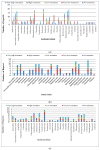Antimicrobial Resistance in Food Animals and the Environment in Nigeria: A Review
- PMID: 29914203
- PMCID: PMC6025306
- DOI: 10.3390/ijerph15061284
Antimicrobial Resistance in Food Animals and the Environment in Nigeria: A Review
Abstract
Antimicrobial resistance (AMR) has emerged as a global health threat, which has elicited a high-level political declaration at the United Nations General Assembly, 2016. In response, member countries agreed to pay greater attention to the surveillance and implementation of antimicrobial stewardship. The Nigeria Centre for Disease Control called for a review of AMR in Nigeria using a “One Health approach”. As anecdotal evidence suggests that food animal health and production rely heavily on antimicrobials, it becomes imperative to understand AMR trends in food animals and the environment. We reviewed previous studies to curate data and evaluate the contributions of food animals and the environment (2000⁻2016) to the AMR burden in Nigeria using a Preferred Reporting Items for Systematic Reviews and Meta-Analyses (PRISMA) flowchart focused on three areas: Antimicrobial resistance, residues, and antiseptics studies. Only one of the 48 antimicrobial studies did not report multidrug resistance. At least 18 bacterial spp. were found to be resistant to various locally available antimicrobials. All 16 residue studies reported high levels of drug residues either in the form of prevalence or concentration above the recommended international limit. Fourteen different “resistotypes” were found in some commonly used antiseptics. High levels of residues and AMR were found in food animals destined for the human food chain. High levels of residues and antimicrobials discharged into environments sustain the AMR pool. These had evolved into potential public health challenges that need attention. These findings constitute public health threats for Nigeria’s teeming population and require attention.
Keywords: Nigeria; antibiotics residue; antimicrobial resistance; bacteria; environment; food animals.
Conflict of interest statement
The authors declare no conflict of interest. The funding sponsors had no role in the design of the study; in the collection, analyses, or interpretation of data; in the writing of the manuscript, and in the decision to publish the results. The funding was part of regular funding block by the University of Pretoria to support research works of their PhD students.
Figures







References
-
- Kingston W. Antibiotics, invention and innovation. Res. Policy. 2000;29:679–710. doi: 10.1016/S0048-7333(99)00045-1. - DOI
-
- O’Neill J. Antimicrobials in Agriculture and the Environment: Reducing Unnecessary Use and Waste. Wellcome Trust; London, UK: 2015. [(accessed on 29 November 2017)]. Available online: https://amr-review.org/sites/default/files/Antimicrobials%20in%20agricul....
-
- O’Neill J. Antimicrobial Resistance: Tackling a Crisis for the Health and Wealth of Nations. Wellcome Trust; London, UK: 2014. [(accessed on 29 November 2017)]. Available online: http://www.amr-review.org.
-
- World Health Organization . Worldwide Country Situation Analysis: Response to Antimicrobial Resistance. World Health Organization; Geneva, Switzerland: 2015. [(accessed on 29 November 2017)]. Available online: http://apps.who.int/iris/bitstream/10665/163468/1/9789241564946_eng.pdf.
-
- O’Neill J. Tackling Drug-Resistant Infections Globally: Final Report and Recommendations: Final Report. Wellcome Trust; London, UK: 2016. [(accessed on 29 November 2017)]. Available online: https://amr-review.org/sites/default/files/160518_Final%20paper_with%20c....
Publication types
MeSH terms
Substances
LinkOut - more resources
Full Text Sources
Other Literature Sources
Medical
Research Materials
Miscellaneous

